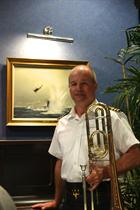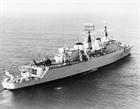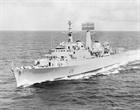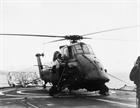Falklands Remembered
Commander Mike Petheram was an officer under training in HMS ANTRIM when the Argentinians invaded; at 24 he was a Sub-Lieutenant coming to the end of his Fleet training and looking forward to his first operational appointment. The Ship was taking part in Exercise SPRINGTRAIN 82 off the Straits of Gibraltar when he became aware something was in the offing ...
We sailed from Gib for the final stages of the exercise at the end of March having heard reports of increasing tension and events in the South Atlantic. We wondered what role we might have to play within any UK response and this became obvious a few days later when instead of turning North and heading for home, we turned South and headed for the South Atlantic. We knew we had been earmarked for something special when we started to take on extra stores and ammunition - by the end we were literally bursting at the seams. Additional members of the Royal Marines and Special Forces were embarked at Ascension Island before continuing South - we had become the Task Force commander for Operation Paraquet, the re-capture of South Georgia; other units involved were HMS CONQUEROR, HMS PLYMOUTH, HMS BRILLIANT, HMS ENDURANCE and RFA TIDESPRING.
We arrived off South Georgia 21 - 23 April and the rest, as they say, is history. The first 2 insertions onto Fortuna Glacier and Grass Island in Stromness Bay didn't go according to plan, but on the 25th, Humphrey (side No: 406), our Wessex 3 helicopter, found the Argentinian submarine Santa Fe on the surface and immediately attacked. This was followed up by further attacks from BRILLIANT's Lynx and ENDURANCE's and PLYMOUTH's Wasps resulting in her being unable to dive. She limped alongside in Grytviken and seizing the initiative - we closed the island at maximum speed with battle ensigns flying - we landed what Royal Marines we had on hand to recapture to Island. The message sent to London ... "Be pleased to inform Her Majesty that the White Ensign flies alongside the Union Jack in South Georgia. God Save the Queen" ... was drafted by the Commander. The next few days were spent dealing with a significant number of Argentinian prisoners of war and seeking the surrender of the remnants of Argentinian forces at their out posts in Leith, Stromness and Husvik.
We then sailed North to rendezvous with the main task force heading South to the Falklands and join them in Op CORPORATE. Preliminary operations to re-capture the islands started in May with the bombing and bombardment of Port Stanley airfield, the sinking of the General Belgrano and two further Argentinian ships found within the total exclusion zone. A few days before the landings, Special Forces conducted a most successful raid destroying many Argentinian aircraft on the ground at Pebble Island, but in spite of these successes, we were also aware of our own setbacks and losses, most notably that of HMS SHEFFIELD to an Exocet attack on 4 May 82.
On the night of 20 May 82, we were given the task of providing Naval Gunfire Support (NGS) to special forces tasked with clearing an Argentinian position on Fanning Head. This overlooked San Carlos Water, the chosen site for the landings, so had to be dealt with prior to any ships entering the bay - infact the SS CANBERRA actually sailed in under the trajectory of our shells. The following dawn broke bright and sunny and as the Argentinians now clearly knew where we were and that the beachhead was established, we braced ourselves for an interesting day. The air attacks started that morning pressed home with great bravery, tenacity and accuracy earning San Carlos Water the nick-name of bomb alley. We were using everything we possibly could - Seacat, 4.5” gun, 20mm Oerlikon, small arms and vegetables - to bring them down, including firing Seaslug at very short range in G.A.S.H. mode. We had developed this on the way South and it stood for “Give Argies the S..ts” and utilised the missile's self destruct capability whenever it lost it's guidance beam. When an incoming raid was detected, the launcher and fire control radar would be turned onto the threat bearing and the fire control radar would be energised - the missile would then be launched looking more like a Space Shuttle taking off due to the 4 wrap around solid boosters used to get the missile to it's operating speed. After approximately 3 to 4 seconds, these boosters would drop off coincident with the guidance beam being switched off, thereby resulting in a huge explosion somewhere between us and the attacking aircraft, hopefully putting him off a bit! Needless to say we didn't score any direct hits, but we reckon we put a few off and apparently on one occasion, managed to demolish an old fish canning factory on West Falkland when the missile failed to self destruct and went rogue after the beam was switched off!
Later that day our luck ran out when we fell victim to a coordinated strafing and bomb attack by a number of aircraft resulting in some fires, damage to the Seaslug and an unexploded bomb lodged in the aft junior rates heads. Sadly we sustained two casualties - one with injuries to his abdomen and another who lost his eyesight as a result of shrapnel ricocheting off the flight deck. We weren't the only ones and we saw HMS ARGONAUT and HMS ARDENT come under intense attack themselves during the day. We continued providing air defence as best we could in the entrance to San Carlos Water before withdrawing that evening once the raids had subsided to deal with the UXB; it was later removed by a RN bomb disposal team and ditched overboard. Repairs were made and the Seaslug patched up with help from STENA SEASPREAD but despite their best efforts, we were unable to restore full operating capability so we spent the rest of the conflict providing protection to the Carrier Group and for the vessels transporting 5th Infantry Brigade, including the QE2, between South Georgia and the Falklands. We kept up to speed with progress in the land campaign via signals and listening to the BBC World Service and ultimately felt confident that having got the troops ashore, it was only a matter of time before the Argentinians surrendered. That said, we remained concerned at the continued attrition and losses to our ships and were saddened to hear of the loss of HMS COVENTRY, ALACRITY, the ATLANTIC CONVEYOR and the devastating attacks upon RFAs SIR GALAHAD and SIR TRISTRAM.
Success came on 14 June 1982 with the unconditional surrender of the Argentinians and we set sail for home shortly thereafter eventually getting back on 17 Jul 82 - a wonderful summers day made all the better by a rapturous welcome from all the Family ... one of the best days of my life! After some leave, I left HMS ANTRIM to start my first operational appointment as the Navigating Officer in HMS STUBBINGTON.





